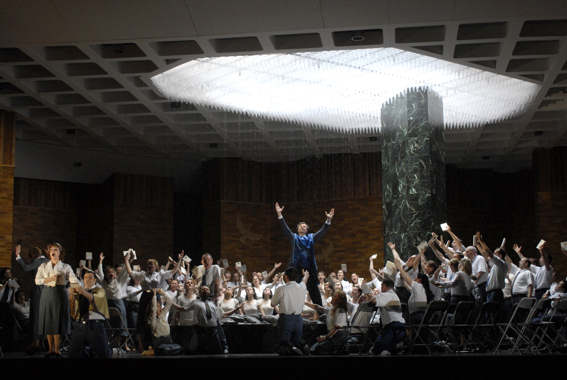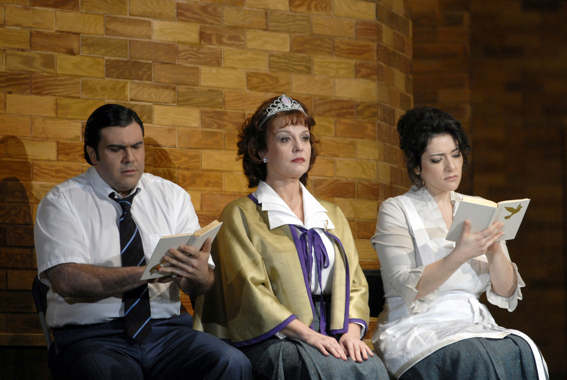Other Links
Editorial Board
- Editor - Bill Kenny
- London Editor-Melanie Eskenazi
- Founder - Len Mullenger
Google Site Search
SEEN
AND HEARD INTERNATIONAL OPERA REVIEW
Verdi, Aida:
new production, Christopher Alden producer, soloists, chorus,
orchestra Deutsche Oper Berlin, Renato Palumbo conductor,
Germany.
2.3.2008 (MM)
The last new
Aida at the Deutsche Oper was fifteen years ago, staged by
the grand old man of West Berlin opera, Götz Fredrich. Thus it was
high time for a new look and the first chance to see it was at its
premiere on March 2nd. Inexplicable, perhaps even foolhardy was
the Deutsche Oper Berlin's choice of an American production team
for this Italian Egyptian classic. Led by stage director
Christopher Alden, the team included Roy Rallo as co-director,
Andrew Lieberman as designer, Doey Luethi as costume designer and
Adam Silverman as lighting designer.
Directors Alden and Rallo's vocal collaborators were eager
participants in the ritual. Soprano Annalisa Raspagliosi was the
beautiful young Aida, seemingly as comfortable polishing the floor
as reaching for her high C. Mexican Tenor Carlo Ventre filled the
shoes of Radames with his fine, well-schooled Italianate tenor,
coolly the sacrificial murderer and the lover of Aida. Mezzo Irina
Mishura made a large voiced, small scale Amneris, most effective
at the end when humiliated in power and love and stripped of her
grace, she delivered the last words of the opera, a curse,
crouched in darkness against the proscenium. Bass Raymond Aceto
exuded a raw, almost real, charisma as the high priest Ramfis,
accompanied always by a mute, ruthless, sexless, stately blond
matron acolyte embodied by Jacqueline Wagner. Baritone Zeljko
Lucic was the less exotic - and in fact confusing - Amonasro,
projecting a human presence, the only such warmth in this
otherwise coldly conceptual Alden/Rallo Aida.

It was a site specific production as Berlin itself was the
protagonist, physically represented on the Deutsche Oper stage by
fine, slick modern architecture that self consciously evokes the
historical and traditional Berlin – massive brick walls, ample
marble, huge block shapes, clumsy neo-gothic references (nothing
at all to do with the international avant guard mercantile Berlin
plops of Renzo Piano, Frank Gehry, or Jean Nouvel). Designer
Andrew Lieberman encased Aida's eight scenes in this interior
space, scene changes marked by light changes, the gamut of Verdi's
atmospheres virtuostically evoked by Adam Silverman.
Just as
Making this new Aida circular, the Alden/Rallo staging
opens with a drowned body dragged from a black marble basin, the
baptismal font in an evangelical church kept spotlessly polished
by Aida, humbling herself as a servant to its massive power. Aida
and the large congregation are clad in DDR socialist uniforms (gray
skirts/pants, white blouses/shirts), holding, sometimes waving
their Maoist bibles. These images from contemporary and recent
history easily recall the countless fanatical tyrants and regimes
that add political piquancy to centuries of opera stories.
The high priest Ramfis, an impeccably suited leader preaches on
his platform, his face and body plastered against the marble,
heaven-directed central pillar, his bible held tightly against the
pillar to take strength from its strength, his voice magically,
extra-corporeally (loud speakers) directing his followers. Radames,
immobile on a folding chair, pours out his Celeste Aida. He
is ordained by the priestess Amneris whose grace is marked by a
symbolic tiara. Aida, Radames and Amneris sit unmoving on three
adjacent downstage chairs to voice the conflicts that will
momentarily rock the foundations of the church.
The Alden/Rallo triumphal scene is a masterpiece of satire with
its frenzy of images illustrating the American mega-church
phenomenon and its insidious use of vanity and self-indulgence as
techniques of mind control. This scene is both highest comedy and
harshest condemnation, yet always with the theatrics of
magnificence that Verdi envisioned for this, his most famous
scene. Capping the first part of the evening the triumphal scene
was rewarded with thunderous applause from the opening night
audience.
Back in the thick of emotional conflict, Aida teased the
high C of O patria mia, and made one of the evening's few
staging movements, walking towards her father, hidden in the midst
of a sea of empty chairs. The Alden staging poetic is based on
developing concept not character. Dramatic tension is generated
through the gradual revelation and friction of larger concepts,
the actors themselves not characters but
concepts. Thus, dramatic interaction is irrelevant, as the music,
voice and body are the symbols and facts of the concept. Alden
succeeds in creating huge tensions, and these tensions palpably
gripped the opening night audience.

Marked by refinement of concept and elegance of realization,
the production was light years away from the blatant and obvious,
if serviceable conducting of Renato Palumbo, oblivious to the
formidable theater art that was happening on the stage.
The one hundred seventy six cast members took bow after bow and
Mr. Palumbo was loudly applauded. After a suspenseful delay the
production team appeared, the audience howled its appreciation and
approval - it only sounded like boos. Maestro Palumbo did
not come to the post-performance party.
Fotos
©
Bettina Stöß
Back
to Top
Cumulative Index Page
